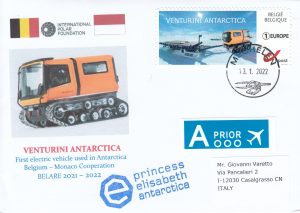 This scientific station, is one of the Argentinean transient Bases on the white continent. Its name is in honor of Benjamín Matienzo, a pioneer of Argentine aviation. In 2009 it became the only Argentine base to have been inhabited exclusively by women.
This scientific station, is one of the Argentinean transient Bases on the white continent. Its name is in honor of Benjamín Matienzo, a pioneer of Argentine aviation. In 2009 it became the only Argentine base to have been inhabited exclusively by women.
Base T.Te Benjamin Matienzo (WAP ARG-Ø1) is located at 64° 58’ South and 60° 08’ West, in the Larsen Nunatak, belonging to the Foca group, on the eastern side of the Peninsula on the Weddell Sea, 186 km southwest of Marambio Base (WAP ARG-21), from where all personnel and cargo transfers are currently made.
The area where the Base is located, was immersed in the Larsen “A” Ice Shelf, completely disintegrated in 1995. Since then, with annual variations, wide sea surfaces with debris and floating icebergs have been exposed. 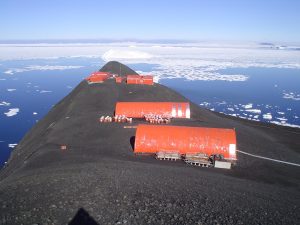 The facilities of the Base occupy a discontinuous strip of about 300 meters in length, at the eastern and narrower end of the nunatak. It was inaugurated on March 15, 1961, located on the old San Antonio Refuge.
The facilities of the Base occupy a discontinuous strip of about 300 meters in length, at the eastern and narrower end of the nunatak. It was inaugurated on March 15, 1961, located on the old San Antonio Refuge.
It was the first Antarctic detachment created jointly between the Argentinean Army and the Air Force, becoming totally dependent on the latter in 1964, with the new name of Teniente Matienzo Air Base, maintaining an endowment of two single-engine Beaver aircraft, operating from the glacier adjacent to the nunatak.
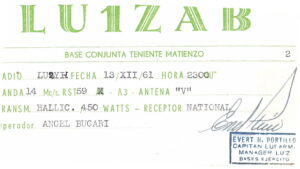 Various scientific activities and historical events of international significance were developed at Matienzo. Extensive meteorological and climatological observation programmes were carried out; the glaciological status of the Matienzo-Esperanza route and the coastal channel between Robertson Island to the South was studied; topographic and aerophotographic surveys of the Larsen Ice Shelf were carried out as well.
Various scientific activities and historical events of international significance were developed at Matienzo. Extensive meteorological and climatological observation programmes were carried out; the glaciological status of the Matienzo-Esperanza route and the coastal channel between Robertson Island to the South was studied; topographic and aerophotographic surveys of the Larsen Ice Shelf were carried out as well.
Pic to the Left, shows an old QSL of LU1ZAB dated 1961, the year of the inauguration of Matienzo Base (TNX LU2YH)
In 1965, two Argentine Gamma Centauro rockets, of national manufacture, were launched along with two balloons probes from Matienzo for X-ray measurement. They moved to the place by means of a transport plane piloted by Commander Mario Luis Olezza. That operation, placed Argentina not only among the small number of countries that built rockets in the 1960s for scientific research, but also carried out launches from Antarctica.
In addition, that same year the Matienzo Base constituted the first stop and the fulcrum of Operation South, the first Argentine Transpolar Flight. Four years later, it was also the base of operations for the creation of the Marambio Base.
In 1972, Matienzo was deactivated as a permanent station and since then it was reopened during most of the summer campaigns to perform tasks of flight support, maintenance of facilities, refueling, meteorological observation and support for scientific activity.
In Matienzo, there is an Antarctic Museum, that has been restored in 2018 and exhibits objects, Antarctic accessories and photographs that recall the history of the base.
In the Antarctic Summer Campaign 2008/2009, Matienzo’s staff was made up entirely of women from the Air Force, constituting a historical fact in Antarctica.
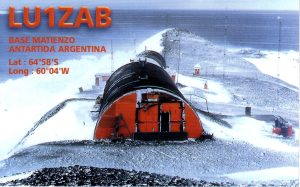 The last reopening of Matienzo was during the 2018 Antarctic Summer Campaign, being operated by a group of ten people, including military and civilians of the Air Force, fulfilling various tasks of maintenance of the facilities and preservation of the environment.
The last reopening of Matienzo was during the 2018 Antarctic Summer Campaign, being operated by a group of ten people, including military and civilians of the Air Force, fulfilling various tasks of maintenance of the facilities and preservation of the environment.
LU1ZAB on air …
After more than 10 years of being inactive, LU1ZAB Matienzo Ham radio Station was activated, which even provided services, as in the old days, for private communications between crew members and their families.
Pic aside and below shows a couple of the last QSLs of LU1ZAB dated 1970 & 1996 (TNX I1UP & I1HYW )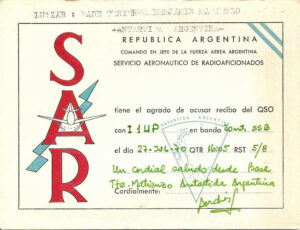
LU1ZAB service, was used as a bridge to make the first radio contacts, later expanded through the phone-patch service, linking the radio equipment with the telephone line, through the Marambio Base.
Thus, the service focuses on the use of radio, in HF bands, historically provided by amateur radio stations could be used directly by those who carry out tasks in Antarctica, as was done so many times in the past.
LU1ZAB amateur radio station’s set up, had several antennas, which allowed testing capabilities and performance, one of the essential functions of this alternative communication service.
 On last weekend of May 2022, about two hundred people, the vast majority with their families, visited the Chilean Antarctic Institute (INACH) in front of the Benjamín Muñoz Gamero Plaza de Armas in Punta Arenas, as part of the activity held on Saturday 28 for Heritage Day. A great cultural festival that was celebrated at a national level and that brought together various public and private institutions.
On last weekend of May 2022, about two hundred people, the vast majority with their families, visited the Chilean Antarctic Institute (INACH) in front of the Benjamín Muñoz Gamero Plaza de Armas in Punta Arenas, as part of the activity held on Saturday 28 for Heritage Day. A great cultural festival that was celebrated at a national level and that brought together various public and private institutions.

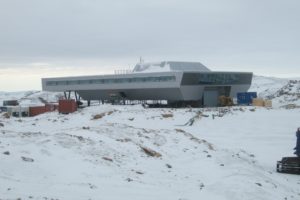 The Bill is introduced to “provide for the national measures for protecting the Antarctic environment and dependent and associated ecosystems and to give effect to the Antarctic Treaty, the Convention on the Conservation of Antarctic Marine Living Resources and to the Protocol on Environmental Protection to the Antarctic Treaty and for matters connected therewith or incidental thereto”.
The Bill is introduced to “provide for the national measures for protecting the Antarctic environment and dependent and associated ecosystems and to give effect to the Antarctic Treaty, the Convention on the Conservation of Antarctic Marine Living Resources and to the Protocol on Environmental Protection to the Antarctic Treaty and for matters connected therewith or incidental thereto”. India signed the Antarctic Treaty on August 19, 1983, and was soon granted the observer status on September 12, 1983. The protocol entered into force for India on January 14, 1998. India has active research stations Maitri (
India signed the Antarctic Treaty on August 19, 1983, and was soon granted the observer status on September 12, 1983. The protocol entered into force for India on January 14, 1998. India has active research stations Maitri ( After months of preparation, a crew of 12 scientists, explorers, and staff at Europe’s Concordia Research Station in Antarctica (
After months of preparation, a crew of 12 scientists, explorers, and staff at Europe’s Concordia Research Station in Antarctica (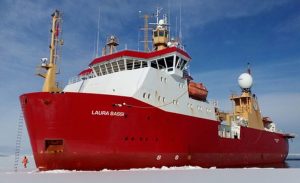 The mission of the I/B Laura Bassi (ex I/B Ernest Shackleton) , owned by the Italian
The mission of the I/B Laura Bassi (ex I/B Ernest Shackleton) , owned by the Italian 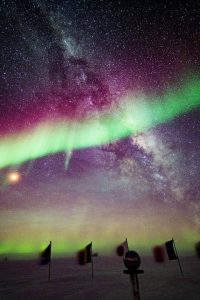 On May 15th, Thomas Leps tooks a break to go outside and photograph the lunar eclipse from the geographic South Pole. Leps operates the international BICEP array at the Amundsen–Scott South Pole Station (
On May 15th, Thomas Leps tooks a break to go outside and photograph the lunar eclipse from the geographic South Pole. Leps operates the international BICEP array at the Amundsen–Scott South Pole Station ( Aimee Sharpe, is the daughter of John Sharpe VK2FR (aka VK2ANT) (
Aimee Sharpe, is the daughter of John Sharpe VK2FR (aka VK2ANT) (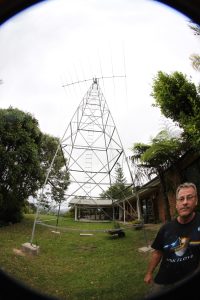 Aimee wrote: «My father’s original call sign VK2FR has recently been taken over by a new person, which I didn’t realize and I am so upset. It is my fault though, I didn’t see the emails to renew. So now I want to make sure I can keep VK2ANT .
Aimee wrote: «My father’s original call sign VK2FR has recently been taken over by a new person, which I didn’t realize and I am so upset. It is my fault though, I didn’t see the emails to renew. So now I want to make sure I can keep VK2ANT .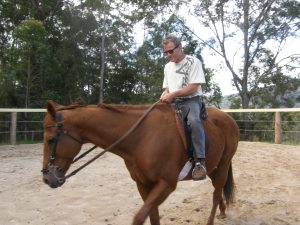 Aimee said that the plan is very exciting: « I can’t wait to see Antarctica. It will be an emotional experience, but very meaningful and I know my dad will be there with me in spirit. It will depend on the weather as to which islands/bays we can stop at, but potentially British Port Lockroy, Chinese Great Wall, Argentine Esperanza and Argentine Almirante Brown. However this is a very loose plan that may change. I think I will just have to be flexible and see when we get there».
Aimee said that the plan is very exciting: « I can’t wait to see Antarctica. It will be an emotional experience, but very meaningful and I know my dad will be there with me in spirit. It will depend on the weather as to which islands/bays we can stop at, but potentially British Port Lockroy, Chinese Great Wall, Argentine Esperanza and Argentine Almirante Brown. However this is a very loose plan that may change. I think I will just have to be flexible and see when we get there».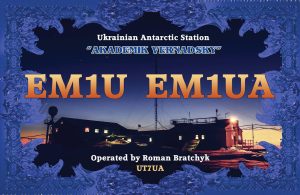 A Ukrainian scientist has told Sky News of her heartbreak at leaving behind loved ones in a war zone while she carries out vital climate research 10,000 miles away in Antarctica.
A Ukrainian scientist has told Sky News of her heartbreak at leaving behind loved ones in a war zone while she carries out vital climate research 10,000 miles away in Antarctica.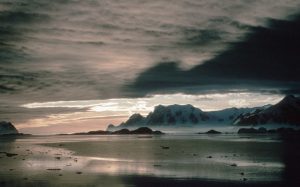 Clouds come in myriad shapes, sizes and types, which control their effects on climate. New research led by the University of Washington shows that the splintering of frozen liquid droplets to form ice shards inside Southern Ocean clouds dramatically affects the clouds’ ability to reflect sunlight back to space.
Clouds come in myriad shapes, sizes and types, which control their effects on climate. New research led by the University of Washington shows that the splintering of frozen liquid droplets to form ice shards inside Southern Ocean clouds dramatically affects the clouds’ ability to reflect sunlight back to space. In Febr. 2014, Josè V Jaramillo (HC3TAC) has been active for 2 days from Punta Arenas-Chile (8 & 9 february 2014).
In Febr. 2014, Josè V Jaramillo (HC3TAC) has been active for 2 days from Punta Arenas-Chile (8 & 9 february 2014).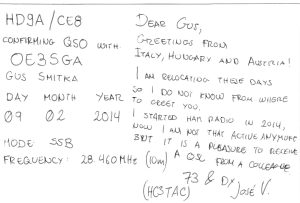 We have been lucky to catch Jose HC3TAC in Italy so we organized the best way to confirm the contacts with those OM who made QSO with him when he was down South.
We have been lucky to catch Jose HC3TAC in Italy so we organized the best way to confirm the contacts with those OM who made QSO with him when he was down South.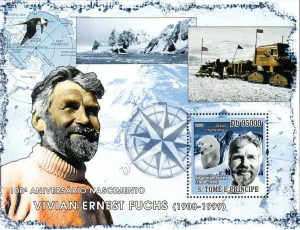 Sir Vivian Ernest Fuchs (11 February 1908 – 11 November 1999) was an English explorer. Fuchs is best known as the leader of the Commonwealth Trans-Antarctic Expedition, a Commonwealth-sponsored expedition that completed the first overland crossing of Antarctica via the South Pole in 1958
Sir Vivian Ernest Fuchs (11 February 1908 – 11 November 1999) was an English explorer. Fuchs is best known as the leader of the Commonwealth Trans-Antarctic Expedition, a Commonwealth-sponsored expedition that completed the first overland crossing of Antarctica via the South Pole in 1958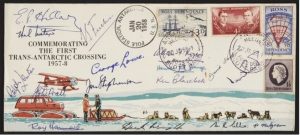 In 1958, Fuchs was knighted by Queen Elizabeth II. He co-wrote, with Sir Edmund Hillary The Crossing of Antarctica. In 1959 he was awarded the Hans Edge Medal by the Royal Danish Geographical Society.
In 1958, Fuchs was knighted by Queen Elizabeth II. He co-wrote, with Sir Edmund Hillary The Crossing of Antarctica. In 1959 he was awarded the Hans Edge Medal by the Royal Danish Geographical Society.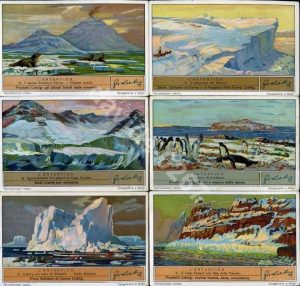 A friend, sent
A friend, sent  Professor Arif Herekar, Professor of Neurology together with excelling in his professional duties is a passionate traveller and globe trotter. He happens to be one of the few Pakistanis to step on to the Antarctic soil, probably the only Pakistani certified as an Antarctic naval seal camping on the Antarctic continent has made this beautiful country Pakistan proud by hoisting the national flag on the Antarctic soil.
Professor Arif Herekar, Professor of Neurology together with excelling in his professional duties is a passionate traveller and globe trotter. He happens to be one of the few Pakistanis to step on to the Antarctic soil, probably the only Pakistani certified as an Antarctic naval seal camping on the Antarctic continent has made this beautiful country Pakistan proud by hoisting the national flag on the Antarctic soil. While on April 25th the world celebrates the penguins, it’s also a time to think about saving them. Many penguin colonies have been lost to climate change and it’s estimated that half the population of emperor penguins will vanish by the end of this century.
While on April 25th the world celebrates the penguins, it’s also a time to think about saving them. Many penguin colonies have been lost to climate change and it’s estimated that half the population of emperor penguins will vanish by the end of this century.
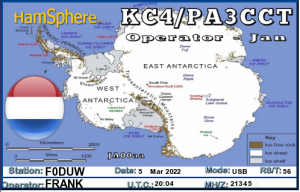 The TX and antenna are for exemple, located in Antarctica but the operator is, for exemple, in Paris. The propagation in Antarctica will be the same of real Amateur Radio. We have dirctional antenna and 100 watts.
The TX and antenna are for exemple, located in Antarctica but the operator is, for exemple, in Paris. The propagation in Antarctica will be the same of real Amateur Radio. We have dirctional antenna and 100 watts.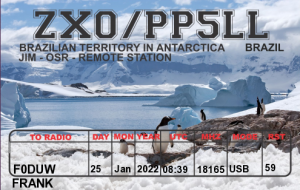 We personally didn’t know that, and now we understood that HamSphere is a subscription-based internet service which simulates Amteur Radio communication over the Internet as designed by Kelly Lindman, 5B4AIT.
We personally didn’t know that, and now we understood that HamSphere is a subscription-based internet service which simulates Amteur Radio communication over the Internet as designed by Kelly Lindman, 5B4AIT.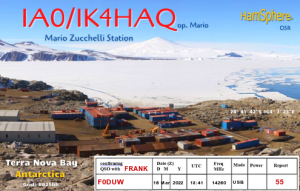
 India has two operational research stations at the South Pole: Maitri (
India has two operational research stations at the South Pole: Maitri (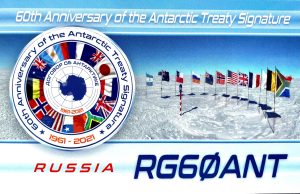 Volker Strecke DL8JDX has just received the Antartida Argentina Plaque and the RG6ØANT special QSL Card on the occasion of the 60th Anniversary of the Antarctic Treaty entering into force.
Volker Strecke DL8JDX has just received the Antartida Argentina Plaque and the RG6ØANT special QSL Card on the occasion of the 60th Anniversary of the Antarctic Treaty entering into force.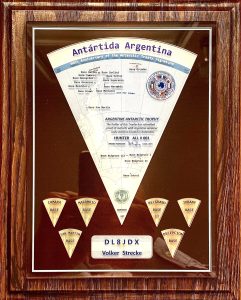 Argentine Antarctica is a part of Antarctica claimed by Argentina as part of its national territory. This claim overlaps with British and Chilean claims in Antarctica.
Argentine Antarctica is a part of Antarctica claimed by Argentina as part of its national territory. This claim overlaps with British and Chilean claims in Antarctica.
 The small branch with its colors, gives hope to all hearts.
The small branch with its colors, gives hope to all hearts. 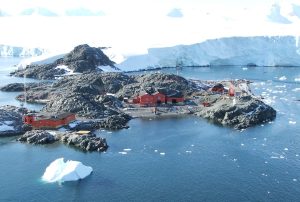 Carlos Almirón (
Carlos Almirón (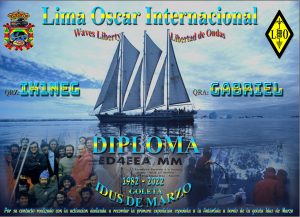 This year, 2022, marks the 40th Anniversary of the first Spanish expedition to Antarctica, carried out aboard the schooner “Idus de Marzo”, organized with the aim of ensuring that Spain meets the requirements for joining the Antarctic Treaty as a full member.
This year, 2022, marks the 40th Anniversary of the first Spanish expedition to Antarctica, carried out aboard the schooner “Idus de Marzo”, organized with the aim of ensuring that Spain meets the requirements for joining the Antarctic Treaty as a full member.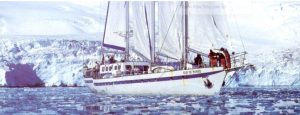 The Ides de Marzo is a schooner that carried the first Spanish scientific expedition to the Antarctic Continent. On December 14, 1982, the schooner departed from the port of Candàs,Asturias, initially with a crew of eight members at the head of which was Captain Javier Babé and Santiago Cañedo, who had the presence of a journalist and two biologists. After stops in Vigo, Las Palmas and Tenerife, from where they sailed south.
The Ides de Marzo is a schooner that carried the first Spanish scientific expedition to the Antarctic Continent. On December 14, 1982, the schooner departed from the port of Candàs,Asturias, initially with a crew of eight members at the head of which was Captain Javier Babé and Santiago Cañedo, who had the presence of a journalist and two biologists. After stops in Vigo, Las Palmas and Tenerife, from where they sailed south.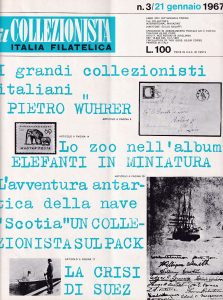 An old copy of “Il Collezionista” an Italian Philatelic Magazine (Jan. 1967) reports a bit of story of the famous Ship Scotia which was depicted on a stamp issued by the Falkland Islands, Scotia was also depicted on two stamps issued by the British Antarctic Territory.
An old copy of “Il Collezionista” an Italian Philatelic Magazine (Jan. 1967) reports a bit of story of the famous Ship Scotia which was depicted on a stamp issued by the Falkland Islands, Scotia was also depicted on two stamps issued by the British Antarctic Territory.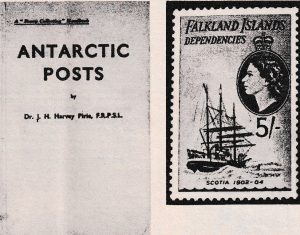 former medical student from University of Edinburg who organised and led the Scottish National Antarctic Expedition (SNAE) from 1902 to1904
former medical student from University of Edinburg who organised and led the Scottish National Antarctic Expedition (SNAE) from 1902 to1904 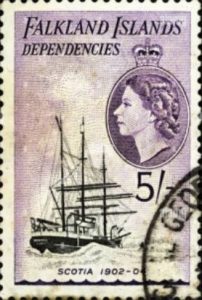 Scotia overwintered in Scotia Bay where she was frozen in for eight months. She departed for the Falkland Islands on 27 November en route for Buenos Aires, Argentina where she underwent a refit. Scotia returned to Laurie Island on 14 February 1904, sailing eight days later for the Weddel Sea. She departed from the Antarctic on 21 March. Calling at Saint Helena in June, she arrived at Millport, Cumbrae, Ayrishire on 21 July, and was escorted by a number of ships to her final destination of Gourock Renfrewshire.
Scotia overwintered in Scotia Bay where she was frozen in for eight months. She departed for the Falkland Islands on 27 November en route for Buenos Aires, Argentina where she underwent a refit. Scotia returned to Laurie Island on 14 February 1904, sailing eight days later for the Weddel Sea. She departed from the Antarctic on 21 March. Calling at Saint Helena in June, she arrived at Millport, Cumbrae, Ayrishire on 21 July, and was escorted by a number of ships to her final destination of Gourock Renfrewshire.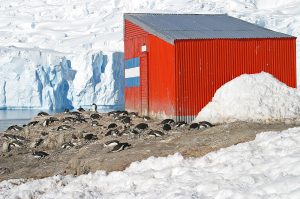 Captain Fliess Refuge (64°50’41” South, 62°31’48” West) is an Argentine Refuge in Antarctica located in Neko Harbour in the Andvord Bay on the Danco Coast, on western side of the Antarctic Peninsula. The refuge was opened on April 4, 1949 and it is managed by the Argentine Navy.
Captain Fliess Refuge (64°50’41” South, 62°31’48” West) is an Argentine Refuge in Antarctica located in Neko Harbour in the Andvord Bay on the Danco Coast, on western side of the Antarctic Peninsula. The refuge was opened on April 4, 1949 and it is managed by the Argentine Navy.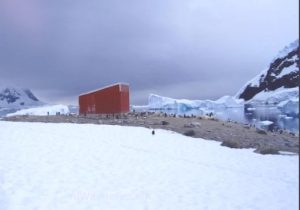
 On
On 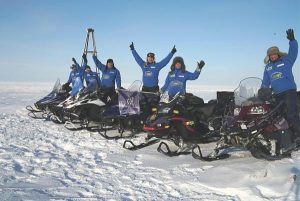 The polar snowmobile expedition R15ØWS from the
The polar snowmobile expedition R15ØWS from the 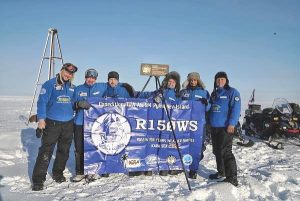 The Team, included Igor Znamensky UA9KDF (Tarko-Sale, YNAO), Andrey Korobeinikov UA9LDD (Tyumen), Andrey Moiseev UAØBA (Norilsk), Viktor Kuzyakin RWØBG (Norilsk), Alexey Bystrov RT9K (Dudinka) and Andrey Prudnikov RT9K (Surgut) did travel 2980 km on snowmobiles to the island and back. During four days of work on air R15ØWS made 5635 QSOs. Of these: CW – 3294, SSB – 1323, FT8 – 1018, 20m – 2878, 30m – 609, 40m – 489, 15m – 570, 12m – 8, 17m – 1072.
The Team, included Igor Znamensky UA9KDF (Tarko-Sale, YNAO), Andrey Korobeinikov UA9LDD (Tyumen), Andrey Moiseev UAØBA (Norilsk), Viktor Kuzyakin RWØBG (Norilsk), Alexey Bystrov RT9K (Dudinka) and Andrey Prudnikov RT9K (Surgut) did travel 2980 km on snowmobiles to the island and back. During four days of work on air R15ØWS made 5635 QSOs. Of these: CW – 3294, SSB – 1323, FT8 – 1018, 20m – 2878, 30m – 609, 40m – 489, 15m – 570, 12m – 8, 17m – 1072. Rykachev, Director of the main geophysical observatory, in honor of the 150th anniversary of the creation of the Russian weather service,
Rykachev, Director of the main geophysical observatory, in honor of the 150th anniversary of the creation of the Russian weather service,
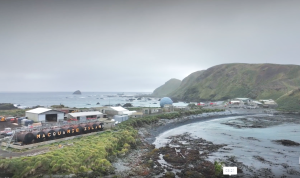 AAD Strategic Infrastructure Manager Adrian Young said good weather had been the helping hand needed get the job done. 350 tonnes of cargo has been delivered to renovate the station.
AAD Strategic Infrastructure Manager Adrian Young said good weather had been the helping hand needed get the job done. 350 tonnes of cargo has been delivered to renovate the station.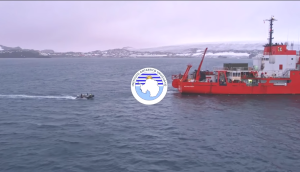 The scientific projects have completed their tasks, and the equipment from Spain used by researchers who have come from that Country, to whom we offer our cooperation in terms of accommodation and use of facilities, given its volume and weight, must return to their country by sea transport.
The scientific projects have completed their tasks, and the equipment from Spain used by researchers who have come from that Country, to whom we offer our cooperation in terms of accommodation and use of facilities, given its volume and weight, must return to their country by sea transport.

 This event is completely unprecedented and upended our expectations about the Antarctic climate system,’ one expert said
This event is completely unprecedented and upended our expectations about the Antarctic climate system,’ one expert said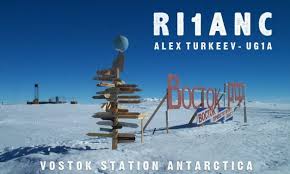 (WAP RUS-14)— at the center of the eastern ice sheet — is around minus-63 (minus-53 Celsius) in March. But on Friday, the temperature leaped to zero (minus-17.7 Celsius), the warmest it’s been there during March since record keeping began 65 years ago. It broke the previous monthly record by a staggering 27 degrees (15 Celsius).
(WAP RUS-14)— at the center of the eastern ice sheet — is around minus-63 (minus-53 Celsius) in March. But on Friday, the temperature leaped to zero (minus-17.7 Celsius), the warmest it’s been there during March since record keeping began 65 years ago. It broke the previous monthly record by a staggering 27 degrees (15 Celsius).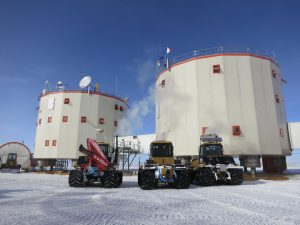 Vostok, a Russian meteorological observatory, is about 808 miles from the South Pole and sits 11,444 feet above sea level. It’s famous for holding the lowest temperature ever observed on Earth: minus-128.6 degrees (minus-89.2 Celsius), set on July 21, 1983.
Vostok, a Russian meteorological observatory, is about 808 miles from the South Pole and sits 11,444 feet above sea level. It’s famous for holding the lowest temperature ever observed on Earth: minus-128.6 degrees (minus-89.2 Celsius), set on July 21, 1983. This scientific station, is one of the Argentinean transient Bases on the white continent. Its name is in honor of Benjamín Matienzo, a pioneer of Argentine aviation.
This scientific station, is one of the Argentinean transient Bases on the white continent. Its name is in honor of Benjamín Matienzo, a pioneer of Argentine aviation.  The facilities of the Base occupy a discontinuous strip of about 300 meters in length, at the eastern and narrower end of the nunatak. It was inaugurated on March 15, 1961, located on the old San Antonio Refuge.
The facilities of the Base occupy a discontinuous strip of about 300 meters in length, at the eastern and narrower end of the nunatak. It was inaugurated on March 15, 1961, located on the old San Antonio Refuge.  Various scientific activities and historical events of international significance were developed at Matienzo. Extensive meteorological and climatological observation programmes were carried out; the glaciological status of the Matienzo-Esperanza route and the coastal channel between Robertson Island to the South was studied; topographic and aerophotographic surveys of the Larsen Ice Shelf were carried out as well.
Various scientific activities and historical events of international significance were developed at Matienzo. Extensive meteorological and climatological observation programmes were carried out; the glaciological status of the Matienzo-Esperanza route and the coastal channel between Robertson Island to the South was studied; topographic and aerophotographic surveys of the Larsen Ice Shelf were carried out as well. The last reopening of Matienzo was during the 2018 Antarctic Summer Campaign, being operated by a group of ten people, including military and civilians of the Air Force, fulfilling various tasks of maintenance of the facilities and preservation of the environment.
The last reopening of Matienzo was during the 2018 Antarctic Summer Campaign, being operated by a group of ten people, including military and civilians of the Air Force, fulfilling various tasks of maintenance of the facilities and preservation of the environment.
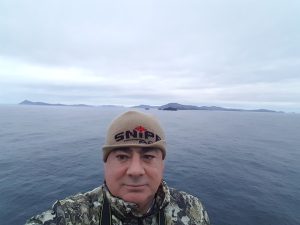 From Cap. Eduardo Abril de Fontcuberta EA4GKV/EO4HAG WAP-242
From Cap. Eduardo Abril de Fontcuberta EA4GKV/EO4HAG WAP-242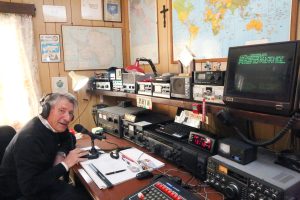 From Gianni I1HYW/IR1ANT WAP ØØ2
From Gianni I1HYW/IR1ANT WAP ØØ2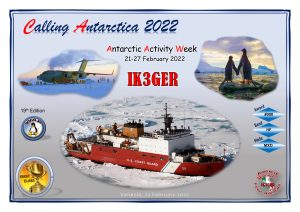
 Thanks to Lt.Danilo Collino IZ1KHY who was recently involved in the 37th Italian Antarctic Season (October 2021 trough February 2022), we have got some recent pictures of the “Chapel of the Snow”, the church been visited by Danilo on his brief stay at McMurdo Station (
Thanks to Lt.Danilo Collino IZ1KHY who was recently involved in the 37th Italian Antarctic Season (October 2021 trough February 2022), we have got some recent pictures of the “Chapel of the Snow”, the church been visited by Danilo on his brief stay at McMurdo Station ( Situated at the end of town, McMurdo Station’s small, blue and white “Chapel of the Snows” stands out against the comparatively drab shipping container-like structures surrounding it. Visitors who step inside the wooden building enter a cozy sanctuary, complete with shelves full of hymnals, musical instruments at the back of the room, and a stained glass window above the pulpit. Other than the black and white penguin embedded in the stained glass, it looks much like any small church around the world.
Situated at the end of town, McMurdo Station’s small, blue and white “Chapel of the Snows” stands out against the comparatively drab shipping container-like structures surrounding it. Visitors who step inside the wooden building enter a cozy sanctuary, complete with shelves full of hymnals, musical instruments at the back of the room, and a stained glass window above the pulpit. Other than the black and white penguin embedded in the stained glass, it looks much like any small church around the world. Chaplain Arthur “Tom” Paine said: “This multi-denominational chapel is for everybody. Months-long deployments away from home can be difficult for many, and the station’s chapel is there to provide a place for people to find personal support and guidance if they need it.”
Chaplain Arthur “Tom” Paine said: “This multi-denominational chapel is for everybody. Months-long deployments away from home can be difficult for many, and the station’s chapel is there to provide a place for people to find personal support and guidance if they need it.”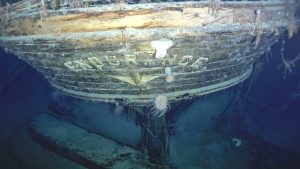 More than a century after its sinking, a scientific expedition “Endurance22” has found the remains of the shipwreck of the Antarctic Explorer Sir Ernest Shackleton (1874-1922), the “Endurance”.
More than a century after its sinking, a scientific expedition “Endurance22” has found the remains of the shipwreck of the Antarctic Explorer Sir Ernest Shackleton (1874-1922), the “Endurance”.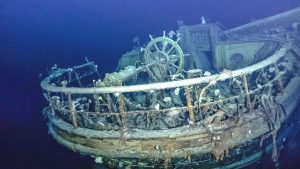 A team of adventurers, marine archaeologists and technicians located the wreck at the bottom of the Weddell Sea, east of the Antarctic Peninsula, using undersea drones. Battling sea ice and freezing temperatures, the team had been searching for more than two weeks in a 150-square-mile area around where the ship went down in 1915. The lost vessel was found at the weekend at the bottom of the Weddell Sea. Scientists have filmed the greatest ever undiscovered shipwrecks 107 years after it sank.
A team of adventurers, marine archaeologists and technicians located the wreck at the bottom of the Weddell Sea, east of the Antarctic Peninsula, using undersea drones. Battling sea ice and freezing temperatures, the team had been searching for more than two weeks in a 150-square-mile area around where the ship went down in 1915. The lost vessel was found at the weekend at the bottom of the Weddell Sea. Scientists have filmed the greatest ever undiscovered shipwrecks 107 years after it sank.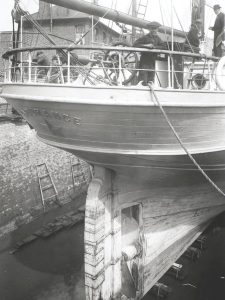 Pic on the Left shows as the stern of Endurance looked in dry dock in 1914 before departure to Antarctica
Pic on the Left shows as the stern of Endurance looked in dry dock in 1914 before departure to Antarctica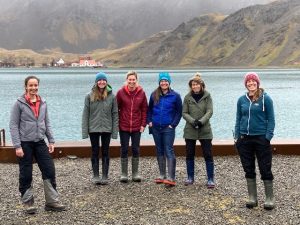
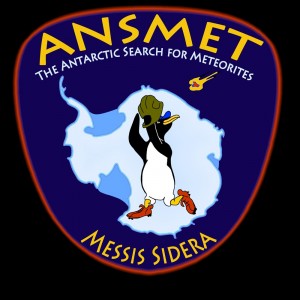 The Antarctic Search for Meteorites program (ANSMET) is a US-led field-based science project that recovers meteorite specimens from Antarctica. Since 1976 we have recovered more than 22,000 specimens from meteorite stranding surfaces along the Transantarctic Mountains. These specimens are a reliable, continuous source of new, non-microscopic extraterrestrial material and support thousands of scientists from around the globs as they seek essential “ground-truth” concerning the materials that make up the asteroids, planets and other bodies of our solar system. The study of ANSMET meteorites has greatly extended our knowledge of the materials and conditions in the primeval nebula from which our solar system was born, revealed the complex and exotic geologic nature of asteroids, and proved, against the conventional wisdom, that some specimens represent planetary materials, delivered to us from the Moon and Mars, free of charge.
The Antarctic Search for Meteorites program (ANSMET) is a US-led field-based science project that recovers meteorite specimens from Antarctica. Since 1976 we have recovered more than 22,000 specimens from meteorite stranding surfaces along the Transantarctic Mountains. These specimens are a reliable, continuous source of new, non-microscopic extraterrestrial material and support thousands of scientists from around the globs as they seek essential “ground-truth” concerning the materials that make up the asteroids, planets and other bodies of our solar system. The study of ANSMET meteorites has greatly extended our knowledge of the materials and conditions in the primeval nebula from which our solar system was born, revealed the complex and exotic geologic nature of asteroids, and proved, against the conventional wisdom, that some specimens represent planetary materials, delivered to us from the Moon and Mars, free of charge. A Team of Thirty-two scientists are sailing to “the place in the world that’s the hardest to get to” so they can better figure out how much and how fast seas will rise because of global warming eating away at Antarctica’s ice.
A Team of Thirty-two scientists are sailing to “the place in the world that’s the hardest to get to” so they can better figure out how much and how fast seas will rise because of global warming eating away at Antarctica’s ice. Marking International Women’s Day, Antarctic experts will share extraordinary untold stories from the icy continent’s past. Join UK Antarctic Heritage Trust on Tuesday 8th March for Untold Stories of Antarctica.
Marking International Women’s Day, Antarctic experts will share extraordinary untold stories from the icy continent’s past. Join UK Antarctic Heritage Trust on Tuesday 8th March for Untold Stories of Antarctica.  Morag Seag, a PhD candidate at the University of Cambridge, will tell the story of women’s integration into Antarctic field science in the mid-twentieth century. Amelia Urry, also a PhD candidate at the University of Cambridge, will share stories of the women behind Antarctic mapping in the 1950s.
Morag Seag, a PhD candidate at the University of Cambridge, will tell the story of women’s integration into Antarctic field science in the mid-twentieth century. Amelia Urry, also a PhD candidate at the University of Cambridge, will share stories of the women behind Antarctic mapping in the 1950s. Deutsche Briefmarken-Zeitung (
Deutsche Briefmarken-Zeitung (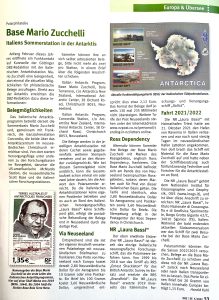 The article includes a copy of Danilo’s QSL and the stamp dedicated to the Italian scientist Mario Zucchelli (1944 – 2003), for years a reference figure for the Italian Antarctic Program.
The article includes a copy of Danilo’s QSL and the stamp dedicated to the Italian scientist Mario Zucchelli (1944 – 2003), for years a reference figure for the Italian Antarctic Program. background.
background.
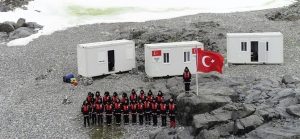
 While the 19th edition of the just started
While the 19th edition of the just started  February 22; next Tuesday, is the “
February 22; next Tuesday, is the “ celebrate the National event and a special QSL-Award used to be issued to the Hams who made contact with this Bases. Above one of this QSL-Award issud on 22 febr. 1983 for a contact with LU1ZG at Base General Belgrano II (
celebrate the National event and a special QSL-Award used to be issued to the Hams who made contact with this Bases. Above one of this QSL-Award issud on 22 febr. 1983 for a contact with LU1ZG at Base General Belgrano II (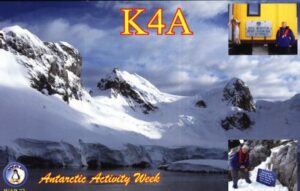 Congrats to Phil Finkle K6EID from Marietta GA, USA for being one of the most present Ham into the
Congrats to Phil Finkle K6EID from Marietta GA, USA for being one of the most present Ham into the 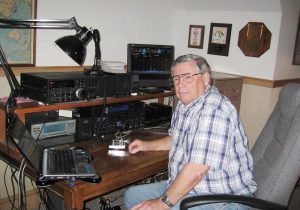
 The legend of El Dorado around the South Pole has fascinated many Europeans since Sir Francis Drake. On the first day of 1739, the looked at the cloudy, foggy and ice-bound coast – the one that would later be called Bouvet Island. Then he returned home with a description of majestic icebergs and black-and-white penguins that looked like «large ducks, but with fins instead of wings».
The legend of El Dorado around the South Pole has fascinated many Europeans since Sir Francis Drake. On the first day of 1739, the looked at the cloudy, foggy and ice-bound coast – the one that would later be called Bouvet Island. Then he returned home with a description of majestic icebergs and black-and-white penguins that looked like «large ducks, but with fins instead of wings».
 Sergiy Shutyayev UT9UX, is active (mostly 20 mts SSB) as EM1U from Ukrainian Antarctic Station Academic Vernadsky (
Sergiy Shutyayev UT9UX, is active (mostly 20 mts SSB) as EM1U from Ukrainian Antarctic Station Academic Vernadsky (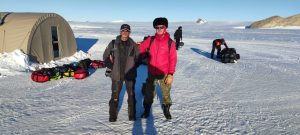 Almost at the end of their Antarctic seson, our friends Oleg ZS7ANF and Sebastian SQ1SGB meet at Wolf’s Fang Runway. (
Almost at the end of their Antarctic seson, our friends Oleg ZS7ANF and Sebastian SQ1SGB meet at Wolf’s Fang Runway. (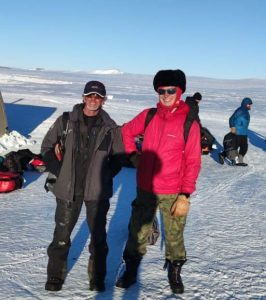 ).
).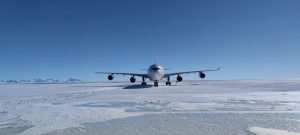 regarded as a well-established and reliable airbridge between Africa and Antarctica.
regarded as a well-established and reliable airbridge between Africa and Antarctica. Sebastian VP8/SQ1SGB (
Sebastian VP8/SQ1SGB (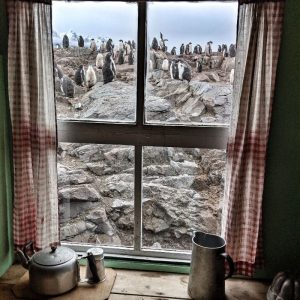 Several interesting features on February e-bulletin of Antarctic Heritage Trust : «our Antarctic season is underway at last. To be able to return a team to Port Lockroy has felt like a significant milestone for us. Despite the many challenges along the way, Lucy, Kit and Tank are finally there and getting stuck into the vital work, work which is proving all the more essential – two years away from the site means there is much maintenance to do….»
Several interesting features on February e-bulletin of Antarctic Heritage Trust : «our Antarctic season is underway at last. To be able to return a team to Port Lockroy has felt like a significant milestone for us. Despite the many challenges along the way, Lucy, Kit and Tank are finally there and getting stuck into the vital work, work which is proving all the more essential – two years away from the site means there is much maintenance to do….»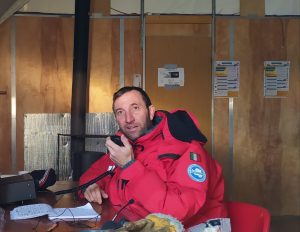 active from Concordia Station (
active from Concordia Station (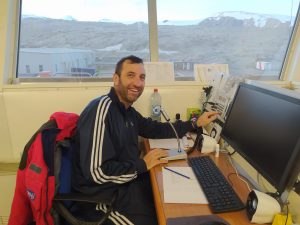 At Mario Zucchelli Station (WAP-Ø1) he is operating from the Radio Room of the Base when it is free of use by the Air traffic control personnel. (see picture on the right)
At Mario Zucchelli Station (WAP-Ø1) he is operating from the Radio Room of the Base when it is free of use by the Air traffic control personnel. (see picture on the right)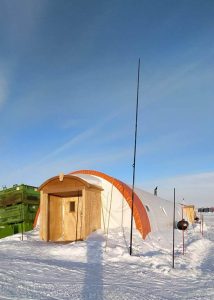 Dome C Summer camp (
Dome C Summer camp (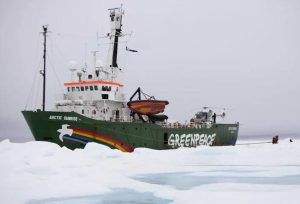 unknown to science. Scientists say this is the furthest south the species has ever been seen in this part of Antarctica, and posit their presence here to the impacts of climate change.
unknown to science. Scientists say this is the furthest south the species has ever been seen in this part of Antarctica, and posit their presence here to the impacts of climate change. Little Dome C, is an area of 10 square km, located at 75° 17’ 57” South, 122° 26’ 43” East, about 40 km from the Italian-French Concordia Station, on the East Antarctic plateau, one of the most extreme places on the Earth.
Little Dome C, is an area of 10 square km, located at 75° 17’ 57” South, 122° 26’ 43” East, about 40 km from the Italian-French Concordia Station, on the East Antarctic plateau, one of the most extreme places on the Earth.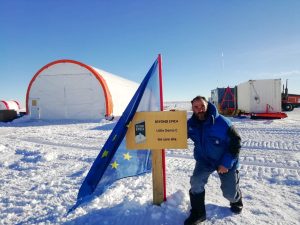
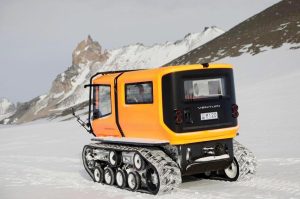 Inspired by HSH Prince Albert II of Monaco Exploration, after he visited Antarctica in 2009, the very first EV’s (Electric Vehicles) it’s currently in service at Belgium’s Princess Elisabeth Antarctica Station (
Inspired by HSH Prince Albert II of Monaco Exploration, after he visited Antarctica in 2009, the very first EV’s (Electric Vehicles) it’s currently in service at Belgium’s Princess Elisabeth Antarctica Station (